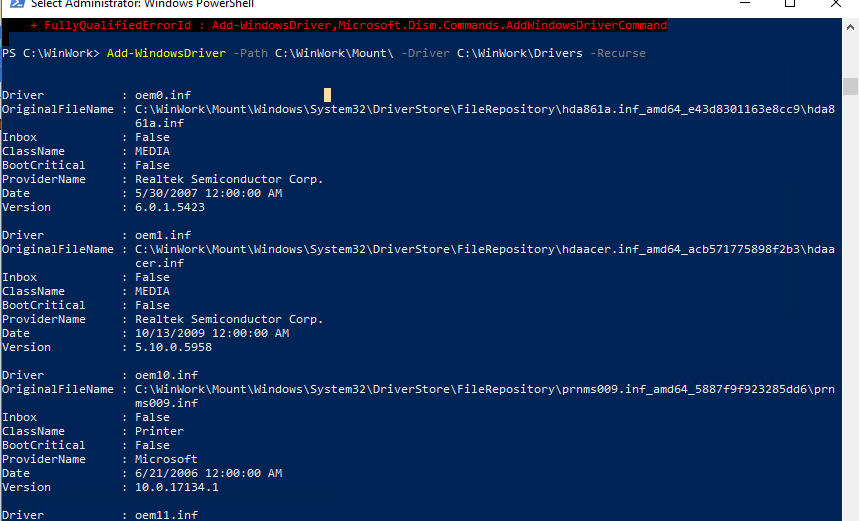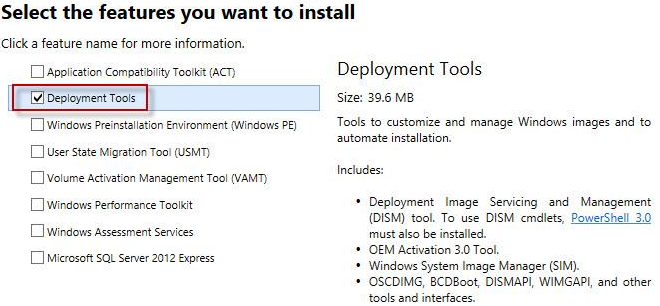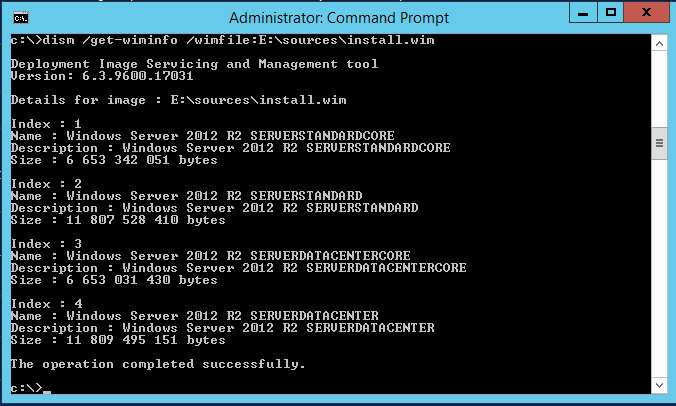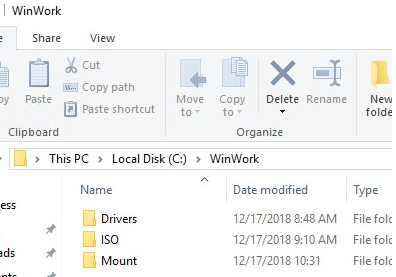How To Add Drivers To Windows Iso
In this article, nosotros will testify you how to add together the necessary device drivers directly into the Windows installation paradigm. The integration of the device drivers into your offline Windows paradigm is widely used when you need to deploy a big number of workstations and servers on the same hardware. Instead of manually installing specific drivers (including AHCI/ RAID/ NVMe) on each device, yous can significantly simplify and accelerate OS deployment process by integrating the drivers direct into the Driver Store of the Windows installation image in the ISO/WIM or the VHD/VHDX file. When installing such an epitome, the Plug and Play service (PnP) will automatically install the necessary drivers for the detected hardware.
This manual is most the integration of device drivers into a Windows epitome and can exist used both on desktop editions of Windows 10, Windows 8.ane and on Windows Server 2016, 2012 R2.
In modern Windows editions you tin can add drivers to the installation ISO image in two means:
- using the DISM utility;
- using the PowerShell CLI.
In fact, both techniques perform the same operation: add additional drivers into the offline Windows image. How to use it is a matter of personal ambassador preference. Let us consider in more detail both ways on the example of integrating drivers into the Windows ten installation image.
Note. In Windows Server 2008 R2 and Windows 7, it was possible to add a commuter to the Windows installation image using the imagex command line tool (included into the WAIK), but information technology is non supported in Windows Server 2012 and subsequently.
Contents:
- How to Inject Driver into a Windows x Install Image using PowerShell?
- Calculation Drivers to an Offline Windows Server 2012 R2 Image Using DISM
How to Inject Driver into a Windows 10 Install Image using PowerShell?
Kickoff of all y'all need to download and identify all the necessary device drivers in one directory (for each driver y'all need to create a split up folder). Please note that many vendors (including Dell, HP) supply their drivers in the grade of self-extracting exe or zip archive files. Such archives must be unpacked to local drive and so that the directory with drivers contains inf, cat and sys files.
Before y'all outset, create the following directory structure on your local drive:
- The Drivers folder – it contains unpacked driver files for your Windows 10 edition (which are supposed to exist integrated into the install media);
You tin can download and unpack the necessary driver files manually or export all third-party drivers from a reference Windows 10 figurer, on which all the necessary drivers are already installed (using the Export-WindowsDriver cmdlet).
- The ISO binder – this directory contains the unpacked iso prototype of Windows x. Y'all merely need the Install.wim file from the Sources directory;
If your Windows 10 ISO epitome contains only the file ..\sources\install.esd, you can convert the ESD file to WIM format using the DISM tool:
dism /export-prototype /SourceImageFile:"C:\WinWork\ISO\install.esd" /SourceIndex:four /DestinationImageFile:C:\WinWork\ISO\install.wim /Compress:max /CheckIntegrity - The Mountain folder – an empty directory into which the Windows install WIM image will exist mounted after.
Listing all Windows editions contained in the Install.wim file using the Go-WindowsImage PowerShell cmdlet. This is necessary in guild to specify the Widows edition into which it is planned to integrate the boosted drivers.
Get-WindowsImage -ImagePath C:\WinWork\ISO\install.wim

In our example, the WIM file contains only one Windows 10 Pro edition with the index one (ImageIndex: 1).
Adjacent you need to mountain the epitome of the selected Windows edition in the directory Mount. The Windows image alphabetize, which you need to mount, must be specified as an argument of the Index parameter:
Mount-WindowsImage -Path C:\WinWork\Mount\ -ImagePath C:\WinWork\ISO\install.wim -Index 1

After the image is mounted, you can add drivers to it from the Drivers directory using the command:
Add together-WindowsDriver -Path C:\WinWork\Mountain\ -Driver C:\WinWork\Drivers -Recurse
The Add-WindowsDriver cmdlet will recursively search (the -Recurse parameter) the specified folder for all *.inf files with driver description. According to the description in the inf file, the cmdlet will add the dependent INF, DLL, CAT, PNF, etc. files to the Driver Shop of your Windows epitome.

So, the drivers are copied, and the current epitome can be unmounted with saving changes:
Dismount-WindowsImage -Path C:\WinWork\Mountain\ –Save

In the above case, we added drivers to the Install.wim image file. This is the Windows paradigm that volition be deployed to a computer local deejay. If you need to add drivers to a Windows boot paradigm (from which the computer boots when you install Windows), you lot need to add drivers to the Boot.wim file. This is usually necessary when installing Windows, the figurer doesn't discover local hard drives or doesn't connect to LAN. Usually, only drivers of deejay controllers and network adapters need to be integrated into the kick.wim image.
You tin can catechumen your install.wim file containing the Windows installation image with integrated drivers into the install.esd format using the DISM shrink option:
DISM /Export-Image /SourceImageFile:C:\WinWork\ISO\install.wim /SourceIndex:1 /DestinationImageFile:C:\WinWork\ISO\install.esd /Compress:recovery
It remains to create an ISO file using Dism++ or the oscdimg control and write it to a disk or USB flash drive:
oscdimg -n -m -bc:\ISO\boot\etfsboot.com C:\ISO C:\new_win10pro_image.iso
There is no Add-WindowsDriver cmdlet in Windows 7 / 2008R2. It appeared only in Windows 8/ Windows Server 2012 and later, therefore to integrate drivers into an image of Win7/2008 R2, utilize the DISM tool (encounter the example below or in the article Adding the USB 3.0 Drivers In Windows vii Installation).
Calculation Drivers to an Offline Windows Server 2012 R2 Image Using DISM
Now nosotros will bear witness an example of integrating drivers into the install image of Windows Server 2012 R2. If you are building an image on Windows 8.1, you will need to download and install Windows eight ADK (http://www.microsoft.com/en-u.s.a./download/details.aspx?id=30652) to proceed working with the latest version of DISM. Y'all need to install the Deployment Tools component.

Use the same directory structure: Drivers (drivers and *.inf files are stored), ISO (unpacked image of Windows Server 2012 R2), Mount (image mountain directory). It is causeless that in the install.wim file we are interested in the Windows Server 2012 R2 Datacenter edition with alphabetize 3.
Mount the install.wim installation epitome:
dism /Mount-Wim /WimFile:c:\iso\sources\install.wim /Index:3 /MountDir:c:\mountain
Run a recursive search and integration of the new drivers into the driver store of the Windows Server 2012 R2 paradigm:
dism /image:c:\mount /Add-Driver "/driver:c:\drivers\" /recurse
Save the changes to the WIM paradigm:
dism /unmount-wim /mountdir:d:\mount /commit
You lot may also accept to integrate drivers for network adapters and disk controllers into the boot image file boot.wim.
If you demand to add drivers to all Windows Server editions independent in the wim file, these operations must be performed for all indexes of Os versions that the command returned:
dism /become-wiminfo /wimfile:d:\install.wim

In improver to driver integration, it is usually necessary to inject security updates to the Windows epitome to exist installed (How to add updates into the Windows installation image). This volition increase the security of your OS immediately subsequently the installation. It remains to write the resulting installation image to the DVD disk or USB flash drive or convert information technology to the ISO image.
How To Add Drivers To Windows Iso,
Source: http://woshub.com/integrate-drivers-to-windows-install-media/
Posted by: whitemashe1946.blogspot.com




0 Response to "How To Add Drivers To Windows Iso"
Post a Comment